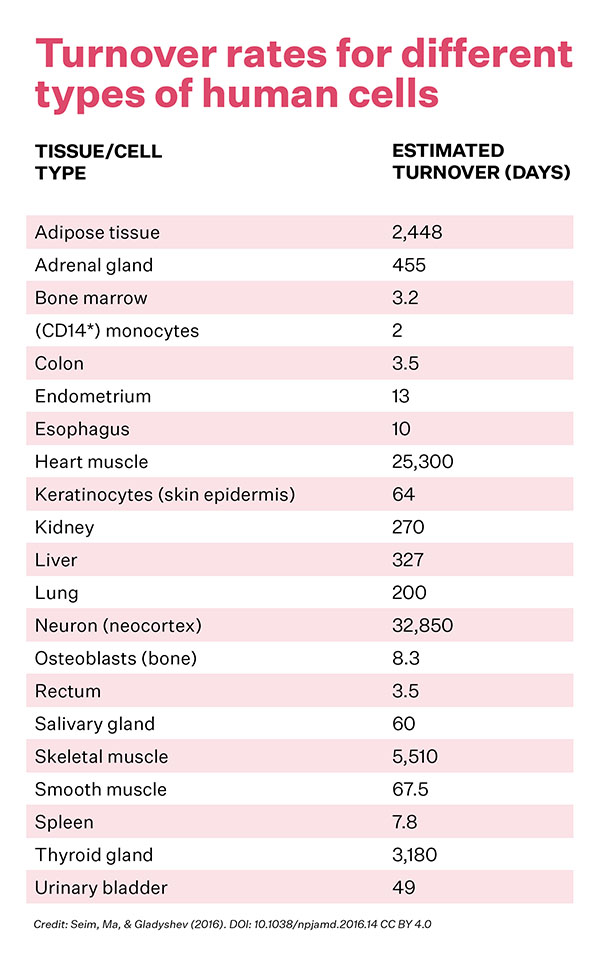Organ-specific biological clocks are the latest tool for predicting and treating both chronic disease and overall aging.
Age is not as simple as a single number—it’s far more nuanced. Two people of the same chronological age could be wildly different, with one being in great health and the other sickly. Even within a single human body, like yours or mine, age isn’t homogenous. Some parts, like your heart, may be strong, healthy, and able to keep strongly pumping for years—even as other organs, like your liver, could be short on days. Ovaries age so fast, experts say, that they are basically geriatric by the time a woman is in her thirties.
One way to think of this is to consider your body as you would a car. Your paint may last for decades unless it’s scratched. Your engine could last for a lifetime as well, so long as it’s well-maintained. But you may need a new clutch in middle age. And your brake pads will wear out much sooner than that. As for your tires… those will need to be replaced every few years. All that can be anticipated by referring to your odometer and the owner’s manual in your glove box.
So where is the dashboard and maintenance schedule for human health? Experts say it’s coming.
The aging clocks
When UCLA scientist Steve Horvath unveiled his so-called Horvath clock, it was a step in this direction. It’s a tool to measure biological aging based on epigenetics, the shifting patterns of methylation and other types of DNA modification that change as we age. The concept of his clock is that as we age, DNA methylation patterns shift. These epigenetic patterns correlate with aging, serving as a kind of biomarker for estimating biological age, a better measure of how quickly we’re aging than chronological age.
Since Horvath revealed the first multi-system clock in 2013, there’s been a race to identify ever-better ways to quantify the rate and impact of aging on human bodies. Increasingly, it’s become clear that on the cellular level different parts of the human body age at different rates. A 2022 study that tracked various biomarkers showed just that. Turnover rates for different types of human cells, which can be used to extrapolate the cells’ lifespans, range from 2 days for a type of white blood cell to 90 years for neuron cells, according to a study of healthy adults.

Scientists don’t agree on the best method of measuring biological organ aging. And despite ongoing research, “there’s no published, validated, system-specific epigenetic clock,” says Dan Belsky, an epidemiologist now at Columbia University who developed DunedinPace, another epigenetic clock that measures the pace of aging. Now a group of researchers at the University of Melbourne has developed a new biological aging clock of sorts. And it doesn’t rely on epigenetic measurements.
“The aging of one body system, one organ system, can profoundly affect the aging of other systems in selective ways,” says Andrew Zalesky, a neuroscientist at the University of Melbourne. He and a team of scientists led by Ye Ella Tian have now taken these systems-focused measurements of biological age one step further with a recent study in Nature Medicine. By mapping the selective impacts of organs aging at variable rates on one another, they’ve created a new way of quantifying and potentially addressing age-related chronic disease risk.
Researchers also found links between the rate of organ-specific aging and lifestyle and demographic factors, associations like proximity to green space that trends alongside a “younger” set of lungs. They also found causal relationships between organ-specific rates of aging. For example, lung aging can cause an increased rate of heart aging which, in turn, can influence how quickly other body systems decline.
Rather than relying on epigenetic aging clocks to measure biological age, the Melbourne scientists derived their “clock” from the UK Biobank, a massive dataset that has been tracking genetic and health metrics of 500,000 people since 2006. In their recent study, the scientists created a new measurement of biological age using data from brain scans and physiological phenotypes, or traits. They used data from healthy adults to train machine-learning models to predict the age of various parts of the body. Comparing that age to the chronological age helped train the model to discern whether, say, the heart, lungs, or kidneys, were older or younger than what’s typical for a given age. This gap was used to derive organ-specific methods for measuring biological age in seven body and three brain systems.
The researchers found relationships between, for example, heart and brain aging. Every year of biological aging in the heart causes a 27-day increase in brain age. Researchers also found links between the biological age of various systems and 16 chronic diseases, including osteoarthritis, diabetes, and cancer. Though these associations don’t show that a particular disease or lifestyle factor causes organ aging, or vice versa, they could be useful in untangling the complex ways these body systems interact.

The real frontier, says Belsky, is shifting from a piecemeal approach to health care—one doctor per organ—to redefining health as a dynamic network of interactions among tissues and organ systems. “That’s the real opportunity for major scientific advance,” he says. But he’s equivocal about whether this latest study and efforts to create system-specific epigenetic clocks advance that goal.
Zalesky sees his efforts as holistic, and a complement to current epigenetic clocks. “The clocks we’ve developed here are from biological phenotypes that we derived from blood and from biomedical imaging,” he says. Unlike current epigenetic clocks, “we can be quite confident that our clocks are specific to an organ system or a body system.”
These findings mean we could target specific organs that are aging faster than the systems around them and potentially slow aging or stave off disease. A better understanding of variations in biological age could also help physicians target therapies to people based on personalized risk factors.
Anne Newman, an expert in the biology of aging and an epidemiologist at the University of Pittsburgh, says that the study does have a “compartmentalizing approach” in its organ-by-organ measurements. Yet, she says, “On the other hand, it shows that if you just deal with one organ system at a time, you’re going to miss these system-level interactions.”
“If you just target one thing, you may not improve the overall health of the person,” Newman continues. She likens these treatment decisions to a trip to the mechanic.
“As your car gets older, everything has wear and tear,” she says. “At what point are you going to replace the muffler or some critical part of it when you know something else is going to go wrong pretty soon?” An accurate, affordable biological aging test is the ace mechanic who realizes your air and fuel mixture is off before you notice a strange smell. Fixing that problem would boost gas mileage, help the car run smoothly, and prevent wear and tear on the engine. Without a good mechanic (or an accurate, affordable aging clock), we may only notice that something is awry when it’s too late, or too costly, to fix. The question is, which measure of aging, which “mechanic,” will we trust?
















